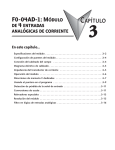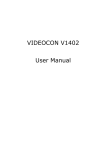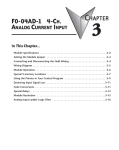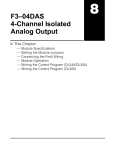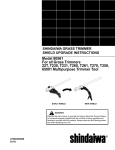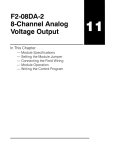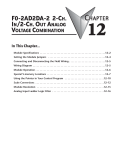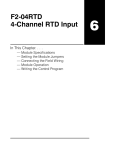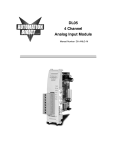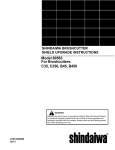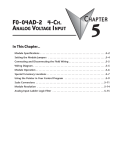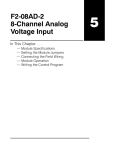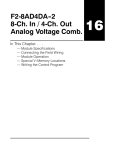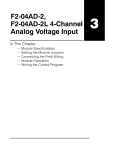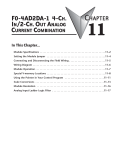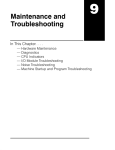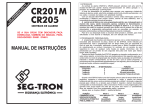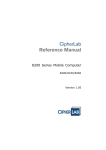Download Chapter 15 - AutomationDirect
Transcript
F0-04THM 4-CHANNEL THERMOCOUPLE INPUT CHAPTER 15 In This Chapter... Module Specifications . . . . . . . . . . . . . . . . . . . . . . . . . . . . . . . . . . . . . . . . . . . . . . .15–2 Connecting and Disconnecting the Field Wiring . . . . . . . . . . . . . . . . . . . . . . . . . .15–4 Module Operation . . . . . . . . . . . . . . . . . . . . . . . . . . . . . . . . . . . . . . . . . . . . . . . . . .15–7 Special V-memory Locations . . . . . . . . . . . . . . . . . . . . . . . . . . . . . . . . . . . . . . . . . .15–8 Configuring the Module in Your Control Program . . . . . . . . . . . . . . . . . . . . . . .15–12 Negative Temperature Readings with Magnitude Plus Sign . . . . . . . . . . . . . . . .15–16 Module Resolution . . . . . . . . . . . . . . . . . . . . . . . . . . . . . . . . . . . . . . . . . . . . . . . .15–18 Analog Input Ladder Logic Filter . . . . . . . . . . . . . . . . . . . . . . . . . . . . . . . . . . . . .15–19 Thermocouple Burnout Detection Bits . . . . . . . . . . . . . . . . . . . . . . . . . . . . . . . . .15–21 Chapter 15: F0-04THM 4-Channel Thermocouple Input 1 2 3 4 5 6 7 8 9 10 11 12 13 14 15 B C D Module Specifications 15–2 The F0-04THM 4-Channel Thermocouple Input Module provides the following features and benefits: • Four thermocouple input channels with 16-bit voltage resolution or 0.1 °C/°F temperature resolution. • Automatically converts type E, J, K, R, S, T, B, N, or C thermocouple signals into direct temperature readings. No extra scaling or complex conversion is required. • Temperature data can be expressed in °F or °C. • Module can be configured as 0–39.0625mVDC, ±39.0625mVDC, ±78.125mVDC, 0–156.25mV, ±156.25mVDC and 0–1.25VDC input and will convert volts and millivolt signal levels into 16-bit digital (0–65535) values. • Signal processing features include automatic cold junction compensation (CJC), thermocouple linearization, and digital filtering. • The temperature calculation and linearization are based on data provided by the National Institute of Standards and Technology (NIST). • Diagnostic features include detection of thermocouple burnout or disconnection. R PW N RU U CP TX1 1 RX TX2 2 RX NOTE: The DL05 CPU’s analog feature for this module requires DirectSOFT32 Version 3.0c (or later) and firmware version 4.60 (or later). The DL06 requires DirectSOFT32 version V4.0, build 16 (or later) and firmware version 1.40 (or later). See our website for more information: www.automationdirect.com. DL05/06 Option Modules User Manual; 7th Ed., Rev. A, 08/11 Chapter 15: F0-04THM 4-Channel Thermocouple Input The following tables provide the specifications for the F0-04THM Analog Input Module. Review these specifications to make sure the module meets your application requirements. General Specifications Number of Channels Common Mode Range Conversion Time Common Mode Rejection Input Impedance Absolute Maximum Ratings Accuracy vs. Temperature Max. full scale error (including offset) PLC Update Rate Power Budget Requirement Operating Temperature Storage Temperature Relative Humidity Environmental Air Vibration Shock Noise Immunity Replacement Terminal Block Wire Size Range & Connector Screw Torque 4, differential inputs, voltage or thermocouple -1.3VDC to +3.8VDC 270ms / channel > 100dB @ 50/60Hz. 5M⏲ min. Fault-protected inputs to ±50 VDC ±15 ppm / ºC maximum; 0 - 1.25V ±35ppm / ºC maximum 4 channels per scan 30mA @ 5VDC (supplied by base) 0 to 60 ºC (32 to 140 ºF) -20 to 70 ºC (-4 to 158 ºF) 5 to 95% (non-condensing) No corrosive gases permitted MIL STD 810C 514.2 MIL STD 810C 516.2 NEMA ICS3-304 F0-IOCON-THM (comes with CJC) 22 - 16 AWG; 0.192Nm; DN-SS1 Screwdriver Recommended Thermocouple Specifications Input Ranges Display Resolution Cold Junction Compensation Warm-Up Time Linearity Error (End to End) Maximum Inaccuracy Type J -190 to 760 ºC (-310 to 1400 ºF) Type K -150 to 1372 ºC (-238 to 2502 ºF) Type E -210 to 1000 ºC (-346 to 1832 ºF) Type R 65 to 1768 ºC (149 to 3214 ºF) Type S 65 to 1768 ºC (149 to 3214 ºF) Type T -230 to 400 ºC (-382 to 752 ºF) Type B 529 to 1820 ºC (984 to 3308 ºF) Type N -70 to 1300 ºC (-94 to 2372 ºF) Type C 65 to 2320 ºC (149 to 4208 ºF) ±0.1 ºC or ±0.1 ºF Automatic 30 minutes typically ± 1 ºC repeatability ±1 ºC maximum, ±0.5 ºC typical ±3 ºC (excluding thermocouple error) Voltage Input Specifications Voltage Ranges Resolution Max. Offset Error (All Input Ranges) Linearity Error (All Input Ranges) Maximum Inaccuracy 0-39.0625mVDC, ±39.0625mVDC, ±78.125mVDC, 0-156.25mVDC, ±156.25mVDC, 0-1.25VDC 16 bit (1 in 65535) 0.05% @ 0-60 ºC; Typical: 0.04% @ 25 ºC 0.05% @ 0-60 ºC; Typical: 0.03% @ 25 ºC 0-39.0625mVDC, ±39.0625mVDC, ±78.125mVDC ranges: 0.1% @ 0-60ºC; Typical: 0.04% @ 25ºC 0-156.25mVDC, ±156.25mVDC, 0-1.25VDC ranges: 0.05% @ 0-60ºC; Typical: 0.04% @ 25ºC 1 2 3 4 5 6 7 8 9 10 11 12 13 14 15 B C D All percentages are calculated as a percent of 216 (65536) counts. (0.025% max error => 0.025 * 65536/100 = 16 counts max error) DL05/06 Option Modules User Manual; 7th Ed., Rev. A, 08/11 15–3 Chapter 15: F0-04THM 4-Channel Thermocouple Input Wiring Guidelines Your company may have guidelines for wiring and cable installation. If so, you should check those before you begin the installation. Here are some general things to consider: • Use the shortest wiring route whenever possible. • Use shielded wiring and ground the shield at the PLC power source. Do not ground the shield at both the transmitter and the PLC power source. • Use thermocouple extension wire that is the same as the thermocouple type when extending the length. • Do not run the signal wiring next to large motors, high current switches, or transformers. This may cause noise problems. • Route the wiring through an approved cable housing to minimize the risk of accidental damage. Check local and national codes to choose the correct method for your application. To remove the terminal block, disconnect power to the PLC and the field devices. Pull the terminal block firmly until the connector separates from the module. You can remove the thermocouple module from the PLC by folding out the retaining tabs at the top and bottom of the module. As the retaining tabs pivot upward and outward, the module’s connector is lifted out of the PLC socket. Once the connector is free, you can lift the module out of its slot. Use the following diagram to connect the field wiring. If necessary, the F0–04THM terminal block can be removed to make removal of the module possible without disturbing field wiring. Thermocouple Input Wiring Diagram All of the module’s CH– terminals must be connected together. This will help eliminate ground potential differences between the input channels that could cause damage to the module. The two unlabeled terminals are internally connected and may be used for convenience to connect the CH– terminals together as shown below. Notes: 1. Shields should be grounded at the PLC power source only. 2. All CH- terminals must be connected together. 3. Unused channels should have a shorting wire (jumper) installed from CH+ to CH-. See NOTE 1 CH1+ CH1– See NOTE 2 CH2+ CJC LM35 CJC CJC ADC 15–4 CH2– MUX The LM35 shown in the diagram is the CJC internal connection 1 2 3 4 5 6 7 8 9 10 11 12 13 14 15 B C D Connecting and Disconnecting the Field Wiring CH3+ CH3– The CJC comes installed on the terminal strip CH4+ See NOTE 3 CH4– DL05/06 Option Modules User Manual; 7th Ed. Rev. A, 08/11 Chapter 15: F0-04THM 4-Channel Thermocouple Input Thermocouples Use shielded thermocouples whenever possible to minimize the presence of noise on the thermocouple wire. Ground the shield wire at one end only. For both grounded and ungrounded thermocouples, connect the shield to the 0V (common) terminal of the PLC power supply. Grounded Thermocouple Assembly A grounded thermocouple provides better response time than an ungrounded thermocouple because the tip of the thermocouple junction is in direct contact with the protective case. Ungrounded Thermocouple Assembly An ungrounded thermocouple is electrically isolated from the protective case. If the case is electrically grounded it provides a low-impedance path for electrical noise to travel. The ungrounded thermocouple provides a more stable and accurate measurement in a noisy environment. To avoid exceeding the common mode specifications, be sure that the machine assembly is properly bonded together. Exposed Grounded Thermocouple The thermocouple does not have a protective case and is directly connected to a device with a higher potential. Grounding the thermocouple assures that the thermocouple remains within the common mode specifications. Because a thermocouple is essentially a wire, it provides a lowimpedance path for electrical noise. The noise filter has a response of >100dB @ 50/60 Hz. WARNING: A thermocouple can become shorted to a high voltage potential. Because common terminals are internally connected together, whatever voltage potential exists on one thermocouple will exist on the other channels. Ambient Variations in Temperature The F0-04THM module has been designed to operate within the ambient temperature range of 0 °C to 60 °C. The cold junction compensation is calibrated to operate in a still-air environment. If the module is used in an application that has forced convection cooling, an error of 2–3 °C may be introduced. To compensate for this you can use ladder logic to correct the values. When configuring the system design it is best to locate any heat-producing devices above and away from the PLC chassis because the heat will affect the temperature readings. For example, heat introduced at one end of the terminal block can cause a channel-to-channel variation. When exposing the F0-04THM module to abrupt ambient temperature changes it will take several minutes for the cold junction compensation and terminal block to stabilize. Errors introduced by abrupt ambient temperature changes will be less than 4 °C. DL05/06 Option Modules User Manual; 7th Ed. Rev. A, 08/11 1 2 3 4 5 6 7 8 9 10 11 12 13 14 15 B C D 15–5 Chapter 15: F0-04THM 4-Channel Thermocouple Input Voltage Input Wiring Diagram All of the module’s CH– terminals must be connected together as shown below. This will help eliminate ground potential differences between the input channels that could cause damage to the module. The two unlabeled terminals are internally connected and may be used for convenience to connect the CH– terminals together as shown below. Notes: 1. Shields should be grounded at the PLC power source. 2. All CH– terminals must be connected together. 3. Unused channels should have a shorting wire (jumper) installed from CH+ to CH–. 4. CJC functionality is automatically disabled when a Voltage input is selected. – Transmitter Supply + CH1+ Voltage Transmitter CH1– CH2+ See NOTE 3 CH2– CJC LM35 CJC Self-powered Voltage Transmitter See NOTE 1 + – ADC CJC MUX The LM35 shown in the diagram is the CJC internal connection 1 2 3 4 5 6 7 8 9 10 11 12 13 14 15 B C D CH3+ CH3– See NOTE 2 + CH4+ Voltage Transmitter 15–6 + – CH4– DL05/06 Option Modules User Manual; 7th Ed. Rev. A, 08/11 The CJC comes installed on the terminal strip. See NOTE 4 Chapter 15: F0-04THM 4-Channel Thermocouple Input Module Operation Channel Scanning Sequence The DL05 and DL06 read the data from all four input channels during each scan. The CPUs support special V-memory locations that are used to manage the data transfer. This is discussed in more detail on the following page, “Special V–memory Locations”. Scan DL05/DL06 PLC Read Inputs Execute Application Program Read the data Store data Scan N Ch 1, 2, 3, 4 Scan N+1 Ch 1, 2, 3, 4 Scan N+2 Ch 1, 2, 3, 4 Scan N+3 Ch 1, 2, 3, 4 Scan N+4 Ch 1, 2, 3, 4 Write to Outputs Analog Module Update Even though the channel updates to the CPU are synchronous with the CPU scan, the module asynchronously monitors the analog transmitter signal and converts the signal to a 16-bit binary representation. This enables the module to continuously provide accurate measurements without slowing down the discrete control logic in the RLL program. The time required to sense the temperature and copy the value to V-memory is 270 milliseconds minimum to 1080 milliseconds plus 1 scan time maximum (number of channels x 270 milliseconds + 1 scan time). DL05/06 Option Modules User Manual; 7th Ed. Rev. A, 08/11 1 2 3 4 5 6 7 8 9 10 11 12 13 14 15 B C D 15–7 Chapter 15: F0-04THM 4-Channel Thermocouple Input 1 2 3 4 5 6 7 8 9 10 11 12 13 14 15 B C D Special V-memory Locations The DL05 and DL06 PLCs have special V-memory locations assigned to their respective option slots. These V-memory locations allow you to: • specify the number of input channels enabled and BCD/Binary data format • specify the input pointer address • specify the thermocouple or voltage input type • specify the units code – temperature scale and data format • enable/disable thermocouple burnout detection • specify burnout data value at burnout • read module setup diagnostics Module Configuration Registers The table below shows the special V-memory locations used by the DL05 and DL06 PLCs for the F0–04THM module. Module Configuration Parameters DL05 and DL06 Option Slot DL05 Slot DL06 Slot 1 DL06 Slot 2 DL06 Slot 3 DL06 Slot 4 V7700 V700 V710 V720 V730 V7701 V7703 V7704 V701 V703 V704 V711 V713 V714 V721 V723 V724 V731 V733 V734 V7705 V705 V715 V725 V735 F: Thermocouple Burnout Data Value V7706 V706 V716 V726 V736 G: Diagnostic Error V7707 V707 V717 V727 V737 A: Number of Channels Enabled / Data Format B: Input Pointer C: Input Type D: Units Code E: Thermocouple Burnout Detection Enable A: Number of Channels Enabled/Data Format Register This V–memory location is used to define the number of input channels to be enabled and to set the channel data to BCD or binary format. Number of Channel Data in Channel Data in Channels Enabled BCD Format Binary Format 1 Channel 2 Channels 3 Channels 4 Channels K100 K200 K300 K400 K8100 K8200 K8300 K8400 MSB LSB Data Format Number of channels 15–8 DL05/06 Option Modules User Manual; 7th Ed. Rev. A, 08/11 Chapter 15: F0-04THM 4-Channel Thermocouple Input B: Input Pointer Register This is a system parameter that points to a V-memory location used for storing module channel input data. The V–memory location loaded in the input pointer V–memory location is an octal number identifying the first V-memory location for the input data. This V–memory location is user defined, but must use available consecutive V-memory locations. For example, loading O2000 causes the pointer to write Ch 1’s data value to V2000/2001, Ch 2’s data value to V2002/2003, CH 3’s data value to V2004/2005 and Ch 4’s data value to V2006/2007. NOTE: Each channel’s data value occupies two (2) consecutive V-memory locations. This allows for more than four (4) digits to be displayed if a BCD format for channel data is selected. For example: 1234.5 °F. A binary format for either a 15-bit magnitude plus sign or 16-bit 2’s complement value will occupy the first V-memory location of the two V-memory locations assigned for the slected channel. Refer to the specific PLC’s user manual being used for available user V-memory locations. C: Input Type Selection Register This V–memory register must be set to match the type of thermocouple being used or the input voltage level. Use the table to determine your settings. Thermocouple/ Voltage Input Type Input Selection Temperature Range °C Temperature Range °F J K E R S T B N C 0-39.0625mVDC ±39.0625mVDC ±78.125mVDC 0-156.25mVDC ±156.25mVDC 0-1.25VDC K0 K1 K2 K3 K4 K5 K6 K7 K8 K9 KA KB KC KD KE -190 to 760 -150 to 1372 -210 to 1000 65 to 1768 65 to 1768 -230 to 400 529 to 1820 -70 to 1300 65 to 2320 N/A N/A N/A N/A N/A N/A -310 to 1400 -238 to 2502 -346 to 1832 149 to 3214 149 to 3214 -382 to 752 984 to 3308 -94 to 2372 149 to 4208 N/A N/A N/A N/A N/A N/A MSB LSB Input Type Selection NOTE: The CJC functionality is automatically disabled when a Voltage input is selected. DL05/06 Option Modules User Manual; 7th Ed. Rev. A, 08/11 1 2 3 4 5 6 7 8 9 10 11 12 13 14 15 B C D 15–9 Chapter 15: F0-04THM 4-Channel Thermocouple Input D: Units Code Register 1 2 3 4 5 6 7 8 9 10 11 12 13 14 15 B C D 15–10 All thermocouple types are converted into a direct temperature reading in either Fahrenheit or Celsius. The data contains one implied decimal place. For example, a value in V-memory of 1002 would be 100.2 °C or °F. For thermocouple ranges which include negative temperatures (J,E,K,T,N), the display resolution is from –3276.7 to +3276.7. For positive-only thermocouple ranges (R,S,B,C), the display resolution is 0 to 6553.5. Negative temperatures can be represented in either 2’s complement or magnitude plus sign form. If the temperature is negative, the most significant bit in the V-memory location is set. The 2’s complement data format may be required to correctly display bipolar data on some operator interfaces. This data format could also be used to simplify averaging a bipolar signal. To view this data format in DirectSoft32, select Signed Decimal. For unipolar thermocouple ranges (R,S,B,C), it does not matter if magnitude plus sign or 2’s complement is selected. The bipolar voltage input ranges may be converted to a 15-bit magnitude plus sign or a 16-bit 2’s complement value. Bit 0 = Temperature Scale (ignored if Voltage input is selected) 0 = Temp in degrees F 1 = Temp in degrees C Bit 1 = Data Format 0 = Magnitude plus sign bit format 1 = 2’s Complement format Unit Code Register - Truth Table Temperature Scale Data Format Bit 1 Bit 0 Value °F Magnitude + sign bit 0 0 K0 °C Magnitude + sign bit 0 1 K1 °F 2’s Complement 1 0 K2 °C 2’s Complement 1 1 K3 Temp scale MSB LSB Data Format DL05/06 Option Modules User Manual; 7th Ed. Rev. A, 08/11 Chapter 15: F0-04THM 4-Channel Thermocouple Input E: Thermocouple Burnout Detection Enable Register This register is used to enable/disable the thermocouple burnout function. Be sure to disable the burnout detection function when checking the module calibration. Bit 0 = Thermocouple Burnout Detection Enable/Disable 0 = Burnout detection is enabled 1 = Burnout detection is disabled MSB LSB Burnout Function F: Thermocouple Burnout Data Value Register This register is used to define either up scale or down scale channel values when a channel thermocouple burnout occurs. Bit 0 = Up scale/down scale value at Burnout 0 = Up scale value at Burnout: Unipolar input type: FFFFh (BCD/HEX) or 65535 (Binary) written to CH register Bipolar input type: 7FFFh (BCD/HEX) or 32767 (Binary) written to CH register 1 = Down scale value at Burnout: 0000h (BCD/HEX) or 0 (Binary) written to CH register MSB LSB Up scale/down scale Burnout value G: Diagnostics Error Register This register is used to determine whether the configuration of the module is valid or not. It is controlled by the PLC and is read only. Bit 0 = Diagnostic bit: 0 = Module setup is valid 1 = Module setup is not valid MSB LSB Diagnostics bit DL05/06 Option Modules User Manual; 7th Ed. Rev. A, 08/11 1 2 3 4 5 6 7 8 9 10 11 12 13 14 15 B C D 15–11 Chapter 15: F0-04THM 4-Channel Thermocouple Input 1 2 3 4 5 6 7 8 9 10 11 12 13 14 15 B C D Configuring the Module in Your Control Program DL05 Example 1 15–12 The example program below shows how to setup the F0–04THM for 4 input channels enabled, J type thermocouple on all 4 input channels, BCD channel data format, ºF temperature scale, magnitude plus sign bit format, and burnout detection enabled with an up scale burnout specified. Place this rung anywhere in the ladder program or in the initial stage if you are using stage programming instructions. This is all that is required to read the temperature or voltage input data into V-memory locations. Once the data is in V-memory you can perform mathematical calculations with the data, compare the data against preset values, etc. V2000 is used in the example but you can use any user V-memory location. SP0 LD K0400 -or - LD K8400 Loads a constant that specifies the number of input channels to scan and the data format. The upper byte, most significant nibble (MSN) selects the data format (0 = BCD, 8 = binary). The LSN selects the number of channels (1, 2, 3 or 4). The binary format is used for displaying data on some operator interface units. K8400 enables 4 channels in binary format. OUT V7700 Special V-memory location assigned to the option slot that specifies the data format and the number of channels to scan. LDA O2000 This loads an octal value for the first V-memory location that will be used to store the incoming data. For example, the O2000 entered here using the LDA instruction would designate the following addresses: Ch1 – V2000/2001, Ch2 – V2002/2003, Ch3 – V2004/2005, Ch4 – V2006/2007. See note on page 15-9. OUT V7701 The octal address (O2000) is stored here. Special V–memory location V7701 is assigned to the option slot and acts as a pointer, which means the CPU will use the octal value in this location to determine exactly where to store the incoming data. LD K0 Loads a 0 into the accumulator to set the following parameters in (V7703 – V7706). OUT V7703 Special V–memory location assigned to the option slot that specifies the thermocouple input type or voltage range selection. CJC is disabled with voltage selected. K0 selects J type thermocouple with CJC enabled. See table on page 15-9 for selections. OUT V7704 Special V–memory location assigned to the option slot that specifies the Units Code (temperature scale and data format) selections. K0 selects º F temperature scale and magnitude plus sign bit format. See truth table on page 15-10 for selections. OUT V7705 Special V–memory location assigned to the option slot that specifies the thermocouple burnout detection enable/disable. K0 selects burnout detection enabled. OUT V7706 Special V–memory location assigned to the option slot that specifies the thermocouple up scale/down scale burnout value. K0 selects an up scale value at burnout. FFFFh for unipolar inputs and 7FFFh for bipolar inputs at burnout. The value is written to the channel input register when a thermocouple burnout occurs. DL05/06 Option Modules User Manual; 7th Ed. Rev. A, 08/11 Chapter 15: F0-04THM 4-Channel Thermocouple Input DL05 Example 2 The example program below shows how to setup the F0–04THM for 2 input channels enabled, use of a K type thermocouple on the first 2 input channels, BCD channel data format, ºC temperature scale, 2’s complement format, and burnout detection enabled with a down scale burnout specified. Again, place this rung in the ladder program or in the intial stage if you are using stage programming instructions. SP0 LD K0200 -or - LD K8200 Loads a constant that specifies the number of input channels to scan and the data format. The upper byte, most significant nibble (MSN) selects the data format (0 = BCD, 8 = binary). The LSN selects the number of channels (1, 2, 3 or 4). The binary format is used for displaying data on some operator interface units. K8200 enables 2 channels in binary format. OUT V7700 Special V-memory location assigned to the option slot that specifies the data format and the number of channels to scan. LDA O2000 This loads an octal value for the first V-memory location that will be used to store the incoming data. For example, the O2000 entered here using the LDA instruction would designate the following addresses: Ch1 – V2000/2001, Ch2 – V2002/2003 See note on page 15-9. OUT V7701 The octal address (O2000) is stored here. Special V–memory location V7701 is assigned to the option slot and acts as a pointer, which means the CPU will use the octal value in this location to determine exactly where to store the incoming data. LD K1 Loads a constant that specifies the input type. K1 selects K type thermocouple with CJC enabled. Enter a K0–K14 to specify the input type. See table on page 15-9 for selections. OUT V7703 Special V–memory location assigned to the option slot that specifies the thermocouple input type or voltage range selection. CJC is disabled when voltage is selected. LD K3 Loads a constant that specifies the Units Code (temperature scale and data format). K3 selects º C and 2’s complement data format. See truth table on page 15-10 for selections. OUT V7704 Special V–memory location assigned to the option slot that specifies the temperature scale and data format selections. LD K0 Loads a constant that enables/disables the thermocouple burnout detection function. K0 selects burnout function enabled. OUT V7705 Special V–memory location assigned to the option slot that specifies the thermocouple burnout detection enable/disable. LD K1 Loads a constant that specifies the thermocouple burnout data value at burnout. K1 specifies a down scale value of 0000h to be written to the channel input register when a thermocouple burnout occurs. OUT V7706 Special V–memory location assigned to the option slot that specifies the thermocouple up scale/down scale burnout value. The value is written to the channel input register when a thermocouple burnout occurs. DL05/06 Option Modules User Manual; 7th Ed. Rev. A, 08/11 1 2 3 4 5 6 7 8 9 10 11 12 13 14 15 B C D 15–13 Chapter 15: F0-04THM 4-Channel Thermocouple Input DL06 Example 1 1 2 3 4 5 6 7 8 9 10 11 12 13 14 15 B C D 15–14 The example program below shows how to setup the F0–04THM in option slot 1 for 4 input channels enabled, use of a J type thermocouple on all 4 input channels, BCD channel data format, ºF temperature scale and magnitude plus sign bit format, and burnout detection enabled with an up scale burnout specified. Use the table shown on page 15–8 to determine the pointer values if locating the module in any of the other slots. Place this rung anywhere in the ladder program or in the initial stage if you are using stage programming instructions. This is all that is required to read the temperature or voltage input data into V-memory locations. Once the data is in V-memory you can perform mathematical calculations with the data, compare the data against preset values, etc. V2000 is used in the example but you can use any user V-memory location. SP0 LD K0400 -or - LD K8400 Loads a constant that specifies the number of input channels to scan and the data format. The upper byte, most significant nibble (MSN) selects the data format (0 = BCD, 8 = binary). The LSN selects the number of channels (1, 2, 3 or 4). The binary format is used for displaying data on some operator interface units. K8400 enables 4 channels in binary format. OUT V700 Special V-memory location assigned to option slot 1 that specifies the data format and the number of channels to scan. LDA O2000 This loads an octal value for the first V-memory location that will be used to store the incoming data. For example, the O2000 entered here using the LDA instruction would designate the following addresses: Ch1 – V2000/2001, Ch2 – V2002/2003, Ch3 – V2004/2005, Ch4 – V2006/2007. See note on page 15-9. OUT V701 The octal address (O2000) is stored here. Special V–memory location V701 is assigned to option slot 1 and acts as a pointer, which means the CPU will use the octal value in this location to determine exactly where to store the incoming data. LD K0 Loads a 0 into the accumulator to set the following parameters in (V703 – V706). OUT V703 Special V–memory location assigned to option slot 1 that specifies the thermocouple input type or voltage range selection. CJC is disabled with voltage selected. K0 selects J type thermocouple and CJC enabled. See table on page 15-9 for selections. OUT V704 Special V–memory location assigned to option slot 1 that specifies the Units Code (temperature scale and data format) selections. K0 selects º F temperature scale and magnitude plus sign bit format. See truth table on page 15-10 for selections. OUT V705 Special V–memory location assigned to option slot 1 that specifies the thermocouple burnout detection enable/disable. K0 selects burnout detection enabled. OUT V706 Special V–memory location assigned to option slot 1 that specifies the thermocouple up scale/down scale burnout value at burnout. K0 selects an up scale value at burnout. FFFFh for unipolar inputs and 7FFFh for bipolar inputs. The value is written to the channel input register when a thermocouple burnout occurs. DL05/06 Option Modules User Manual; 7th Ed. Rev. A, 08/11 Chapter 15: F0-04THM 4-Channel Thermocouple Input DL06 Example 2 The example program below shows how to setup the F0–04THM in option slot 2 for 2 input channels enabled, use of a K type thermocouple on the first 2 input channels, BCD channel data format, ºC temperature scale, 2’s complement format, and burnout detection enabled with a down scale burnout specified. Use the table shown on page 15–8 to determine the pointer values if locating the module in any of the other slots. V-memory location V3000 is shown in the example, but you can use any available user V-memory location. Again, place this rung anywhere in the ladder program or in the initial stage if you are using stage programming instructions. SP0 LD K0200 - or - LD K8200 Loads a constant that specifies the number of input channels to scan and the data format. The upper byte, most significant nibble (MSN) selects the data format (0 = BCD, 8 = binary). The LSN selects the number of channels (1, 2, 3 or 4). The binary format is used for displaying data on some operator interface units. K8200 enables 2 channels in binary format. OUT V710 Special V-memory location assigned to option slot 2 that specifies the data format and the number of channels to scan. LDA O3000 This loads an octal value for the first V-memory location that will be used to store the incoming data. For example, the O3000 entered here using the LDA instruction would designate the following addresses: Ch1 – V3000/3001, Ch2 – V3002/3003 See note on page 15-9. OUT V711 The octal address (O3000) is stored here. Special V–memory location V711 is assigned to option slot 2 and acts as a pointer, which means the CPU will use the octal value in this location to determine exactly where to store the incoming data. LD K1 Loads a constant that specifies the input type. K1 selects K type thermocouple with CJC enabled. Enter a K0–K14 to specify the input type. See table on page 15-9 for selections. OUT V713 Special V–memory location assigned to option slot 2 that specifies the thermocouple input type or voltage range selection. CJC is disabled when voltage is selected. LD K3 Loads a constant that specifies the Units Code (temperature scale and data format). K3 selects º C and 2’s complement data format. See truth table on page 15-10 for selections. OUT V714 Special V–memory location assigned to option slot 2 that specifies the temperature scale and data format selections. LD K0 Loads a constant that enables/disables the thermocouple burnout detection function. K0 selects burnout function enabled. OUT V715 Special V–memory location assigned to option slot 2 that specifies the thermocouple burnout detection enable/disable. LD K1 Loads a constant that specifies the thermocouple burnout data value. K1 specifies a down scale value of 0000h to be written to the channel input register when a thermocouple burnout occurs. OUT V716 Special V–memory location assigned to option slot 2 that specifies the thermocouple up scale/down scale burnout value. The value is written to the channel input register when a thermocouple burnout occurs. DL05/06 Option Modules User Manual; 7th Ed. Rev. A, 08/11 1 2 3 4 5 6 7 8 9 10 11 12 13 14 15 B C D 15–15 Chapter 15: F0-04THM 4-Channel Thermocouple Input 1 2 3 4 5 6 7 8 9 10 11 12 13 14 15 B C D Negative Temperature Readings with Magnitude Plus Sign With bipolar ranges, you need some additional logic to determine whether the value being returned represents a positive temperature/voltage or a negative temperature/voltage. There is a simple solution: • If you are using bipolar ranges and you get a value greater than or equal to 8000h, the value is negative. • If you get a value less than or equal to 7FFFh, the value is positive. The sign bit is the most significant bit, which combines 8000h to the data value. If the value is greater than or equal to 8000h, you only have to mask the most significant bit and the active channel bits to determine the actual data value. The following two programs show how you can accomplish this. The first example uses magnitude plus sign (binary) and the second example uses magnitude plus sign (BCD). Since you always want to know when a value is negative, these rungs should be placed before any other operations that use the data, such as math instructions, scaling operations, and so forth. Also, if you are using stage programming instructions, these rungs should be in a stage that is always active. Note: you only need this logic for each channel that is using bipolar input signals. The examples only show two channels. Magnitude Plus Sign (Binary) 15–16 Check Channel 1 SP1 V2000 LD V2000 Load channel 1 data from V-memory into the accumulator. Contact SP1 is always on. AND K7FFF This instruction masks the sign bit of the binary data, if it is set. Without this step, negative values will not be correct so do not forget to include it. OUT V2010 Put the actual signal value in V2010. Now you can use the data normally. K8000 욷 Check Channel 2 SP1 V2002 K8000 욷 C1 OUT Channel 1 data is negative when C1 is on (a value of –1.0 reads as 8010, –2.0 is 8020, etc.). LD V2002 Load channel 2 from V-memory into the accumulator. Contact SP1 is always on. AND K7FFF This instruction masks the sign bit of the binary data, if it is set. Without this step, negative values will not be correct so do not forget to include it. OUT V2012 Put the actual signal value in V2012. Now you can use the data normally. C2 OUT Channel 2 data is negative when C2 is on (a value of –1.0 reads as 8010, –2.0 is 8020, etc.). DL05/06 Option Modules User Manual; 7th Ed. Rev. A, 08/11 Chapter 15: F0-04THM 4-Channel Thermocouple Input Magnitude Plus Sign (BCD) Check Channel 1 SP1 V2001 LDD V2000 Load channel 1 data from V-memory into the accumulator. Remember, the data can be negative. Contact SP1 is always on. ANDD K7FFFFFFF This instruction masks the sign bit of the BCD data, if it is set. Without this step, negative values will not be correct so do not forget to include it. OUTD V2010 Put the actual signal value in V2010. Now you can use the data normally. K8000 C1 욷 OUT Check Channel 2 SP1 V2003 K8000 욷 Channel 1 data is negative when C1 is on (a value of –1.0 reads as 8000 0010, –2.0 is 8000 0020, etc.). LDD V2002 Load channel 2 from V-memory into the accumulator. Remember, the data can be negative. Contact SP1 is always on. ANDD K7FFFFFFF This instruction masks the sign bit of the BCD data, if it is set. Without this step, negative values will not be correct so do not forget to include it. OUTD V2012 Put the actual signal value in V2012. Now you can use the data normally. C2 OUT Channel 2 data is negative when C2 is on (a value of –1.0 reads as 8000 0010, –2.0 is 8000 0020, etc.). DL05/06 Option Modules User Manual; 7th Ed. Rev. A, 08/11 1 2 3 4 5 6 7 8 9 10 11 12 13 14 15 B C D 15–17 Chapter 15: F0-04THM 4-Channel Thermocouple Input 1 2 3 4 5 6 7 8 9 10 11 12 13 14 15 B C D Module Resolution Module Resolution 16-Bit (Unipolar Voltage Input) Unipolar analog signals are converted into 65536 (216) counts ranging from 0 to 65535. For example, with a 0 to 156.25mVDC signal range, 78mVDC would be 32767. A value of 65535 represents the upper limit of the range. Unipolar Resolution = 5VDC 156.25 mVDC 2.5VDC 78 mVDC 0VDC 0 VDC H–L 65535 H or L = high or low limit of the range 0 32767 65535 Counts Module Resolution 15-Bit Plus Sign (Bipolar Voltage Input) 15–18 The module has 16-bit unipolar or 15bit + sign bipolar resolution. Bipolar analog signals are converted into 32768 (215) counts ranging from 0 to 32767. For example, with a –156.25mVDC to 156.25mVDC input signal range, 156.25mVDC would be 32767. The bipolar ranges utilize a sign bit to provide 16-bit resolution. A value of 32767 can represent the upper limit of either side of the range. Use the sign bit to determine negative values. 156.25 mVDC 5 VDC 0 VDC 0 VDC –156.25 –5 VDC mVDC 32767 (sign bit = 1) 0 Counts Bipolar Resolution = H–L 32767 H or L = high or low limit of the range DL05/06 Option Modules User Manual; 7th Ed. Rev. A, 08/11 32767 (sign bit = 0) Chapter 15: F0-04THM 4-Channel Thermocouple Input Analog Input Ladder Logic Filter PID Loops / Filtering: Please refer to the “PID Loop Operation” chapter in the DL06 or DL05 User Manual for information on the built-in PV filter (DL05/06) and the ladder logic filter (DL06 only) shown below. A filter must be used to smooth the analog input value when auto tuning PID loops to prevent giving a false indication of loop characteristics. Smoothing the Input Signal (DL06 only): The filter logic can also be used in the same way to smooth the analog input signal to help stabilize PID loop operation or to stabilize the analog input signal value for use with an operator interface display, etc. WARNING: The built-in and logic filters are not intended to smooth or filter noise generated by improper field device wiring or grounding. Small amounts of electrical noise can cause the input signal to bounce considerably. Proper field device wiring and grounding must be done before attempting to use the filters to smooth the analog input signal. Using Binary Data Format SP1 LD V2000 Loads the analog signal, which is in binary format and has been loaded from V-memory location V2000, into the accumulator. Contact SP1 is always on. BTOR Converts the binary value in the accumulator to a real number. SUBR V1400 Subtracts the real number stored in location V1400 from the real number in the accumulator, and stores the result in the accumulator. V1400 is the designated workspace in this example. MULR R0.2 Multiplies the real number in the accumulator by 0.2 (the filter factor), and stores the result in the accumulator. This is the filtered value. The filter range is 0.1 to 0.9. Smaller filter factors increases filtering. (1.0 eliminates filtering). ADDR V1400 Adds the real number stored in location V1400 to the real number filtered value in the accumulator, and stores the result in the accumulator. OUTD V1400 Copies the value in the accumulator to location V1400. RTOB Converts the real number in the accumulator to a binary value, and stores the result in the accumulator. OUT V1402 Loads the binary number filtered value from the accumulator into location V1402 to use in your application or PID loop. DL05/06 Option Modules User Manual; 7th Ed. Rev. A, 08/11 1 2 3 4 5 6 7 8 9 10 11 12 13 14 15 B C D 15–19 Chapter 15: F0-04THM 4-Channel Thermocouple Input 1 2 3 4 5 6 7 8 9 10 11 12 13 14 15 B C D NOTE: Be careful not to do a multiple number conversion on a value. For example, if you are using the pointer method in BCD format to get the analog value, it must be converted to binary (BIN) as shown below. If you are using the pointer method in Binary format, the conversion to binary (BIN) instruction is not needed. Using BCD Data Format 15–20 SP1 LDD V2000 Loads the analog signal, which is in BCD format and has been loaded from V-memory location V2000, into the accumulator. Contact SP1 is always on. BIN Converts a BCD value in the accumulator to binary. BTOR Converts the binary value in the accumulator to a real number. SUBR V1400 Subtracts the real number stored in location V1400 from the real number in the accumulator, and stores the result in the accumulator. V1400 is the designated workspace in this example. MULR R0.2 Multiplies the real number in the accumulator by 0.2 (the filter factor), and stores the result in the accumulator. This is the filtered value. The filter range is 0.1 to 0.9. Smaller filter factors increases filtering. (1.0 eliminates filtering). ADDR V1400 Adds the real number stored in location V1400 to the real number filtered value in the accumulator, and stores the result in the accumulator. OUTD V1400 Copies the value in the accumulator to location V1400. RTOB Converts the real number in the accumulator to a binary value, and stores the result in the accumulator. BCD OUTD V1402 Converts the binary value in the accumulator to a BCD number. Note: The BCD instruction is not needed for PID loop PV (loop PV is a binary number). Loads the BCD number filtered value from the accumulator into location V1402 to use in your application or PID loop. DL05/06 Option Modules User Manual; 7th Ed. Rev. A, 08/11 Chapter 15: F0-04THM 4-Channel Thermocouple Input Thermocouple Burnout Detection Bits Special Relays Corresponding to Thermocouple Burnouts The following Special Relay (SP) bits can be used in your program to monitor for thermocouple burnout. SP bit : 0 = Thermocouple OK 1 = Thermocouple burnout DL05 and DL06 Option Slot Module Channel DL05 Slot DL06 Slot 1 DL06 Slot 2 DL06 Slot 3 DL06 Slot 4 Channel 1 SP600 SP140 SP240 SP340 SP440 Channel 2 SP601 SP141 SP241 SP341 SP441 Channel 3 SP602 SP142 SP242 SP342 SP442 Channel 4 SP603 SP143 SP243 SP343 SP443 DL05/06 Option Modules User Manual; 7th Ed. Rev. A, 08/11 1 2 3 4 5 6 7 8 9 10 11 12 13 14 15 B C D 15–21 DL05/06 Option Modules User Manual; 7th Ed. Rev. A, 08/11























